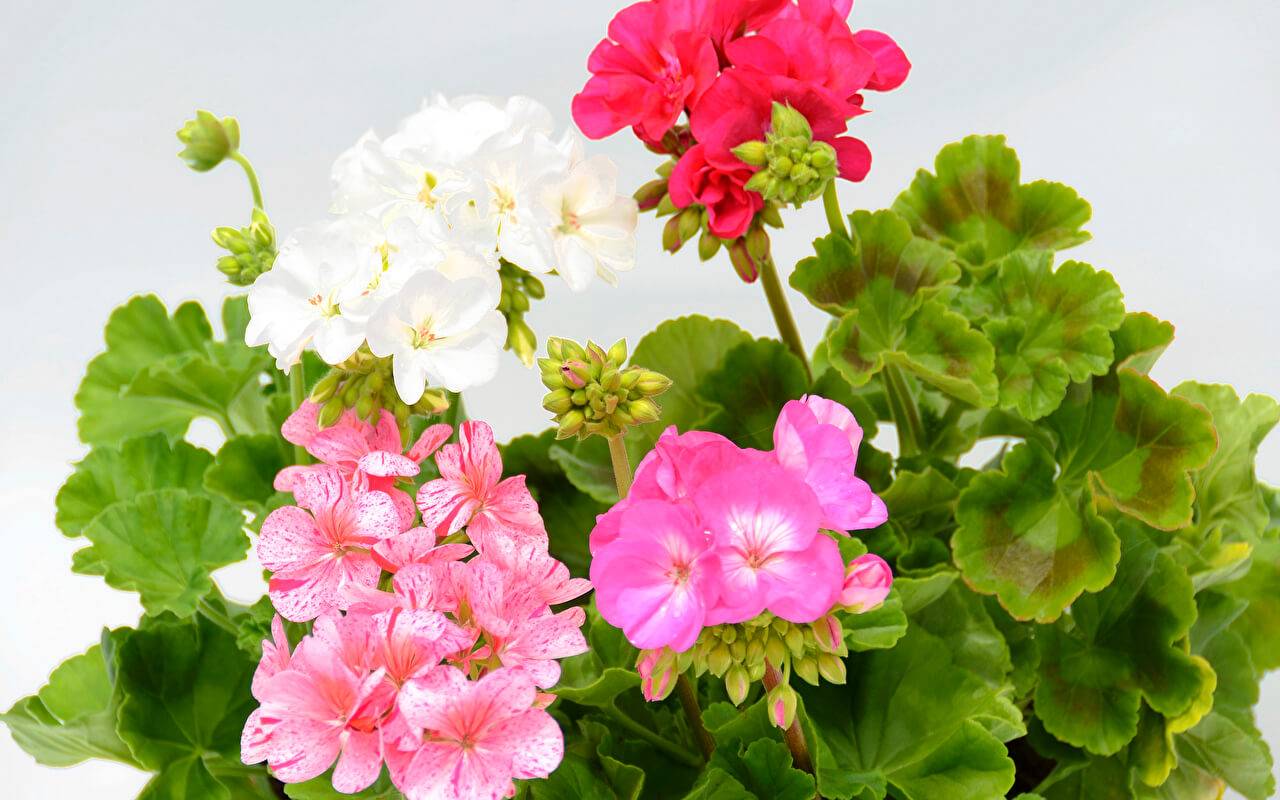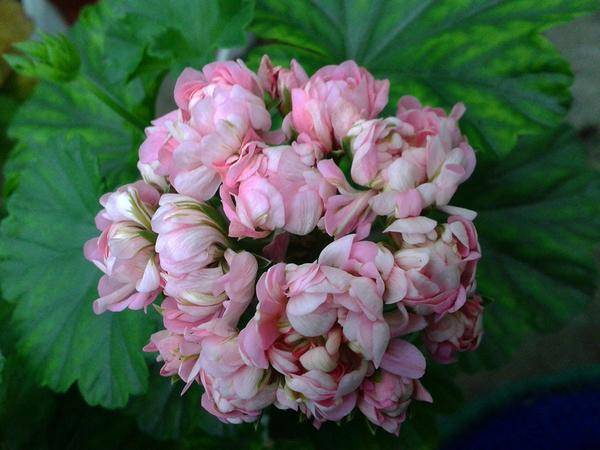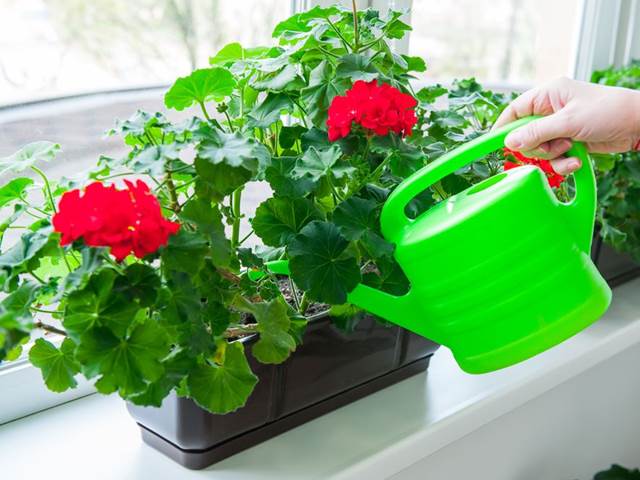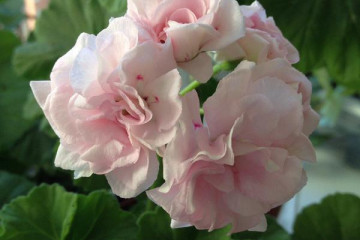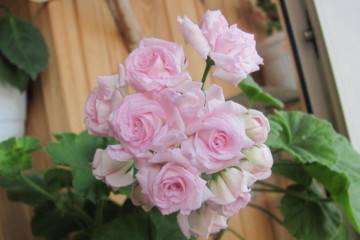Pelargonium Anita
Content:
Pelargonium Anita outwardly fully justifies its gentle feminine name. This is one of the most attractive varieties that flower growers really like. Anita quickly gained widespread acceptance and acceptance. Despite the fact that the flower cannot be called overly demanding, in order to obtain the desired lush flowering, you will need to fulfill a number of necessary conditions.
Pelargonium Anita (Anita) - what kind of rosebud variety
Pelargonium Anita belongs to the Geraniev family. However, this is a hybrid variety obtained by crossing geraniums and rosaceous indoor flowers. Such pelargoniums are called rosebud. They are characterized by inflorescences, reminiscent of several assembled rose buds, and the leaves of a standard geranium.
Brief description and history of origin
Anita, like all other rosebud pelargoniums, is the result of artificial selection. However, now the species characteristics have taken root, and the plants constitute a separate independent species of pelargonium.
Basic description of Anita Pelargonium:
- the most important detail in the description of Anita pelargonium is the beautiful inflorescences, each flower in which resembles a miniature rose. Their color is pale pink. There are a large number of petals in the bud, due to which the flower looks more magnificent;
- flowers are rounded, tightly closed so that the core always remains closed;
- many inflorescences can form during the season, which gives the plant an elegant, bright look;
- leaves are glossy light green. They are the perfect backdrop for lush inflorescences of delicate color.
Growing pelargonium Anita: conditions at home
Pelargonium of this variety is not too demanding, but the basic conditions should be taken into account: temperature, humidity, feeding, lighting, soil quality. Only then will the flower delight its owner with lush large inflorescences and long flowering.
Illumination and temperature conditions
The best air temperature is considered to be in the range of 18-25 ° С. In summer, Anita, like other varieties of rosebud pelargonium, can be taken out onto an open terrace, balcony or garden. She will feel comfortable even in a mild sub-zero temperature. Therefore, you can keep it there until the onset of the first autumn cold weather. In winter, geraniums need a dormant period at a temperature of about 10 ° C. If the plant is not allowed to rest, flowering may not occur.
In order for rosebud pelargonium to bloom luxuriantly and in a timely manner, it will need a lot of sunlight. In this case, it is better to choose a room where the light will not be direct, but diffused, since delicate leaves are sensitive to sunburn.
Watering rules and humidity
Watering Anita is done as needed.Water is poured as soon as the topsoil dries out. Water the geraniums carefully, trying to avoid moisture getting on the delicate leaves. The water should be at room temperature and well-separated. In the summer heat, daily watering is possible - in the morning and in the evening. In winter, it is worth reducing it to a minimum, once a week will be enough.
Pelargonium does not need spraying and high humidity. This criterion is not important for her, so that everything is good, it is worth adhering to the golden mean.
Top dressing and soil quality
Anita geranium is demanding on the composition and quality of the soil. The soil should be nutritious and loose. The best is the composition of 40% turf, 20% peat soil and humus, 10% fine perlite and coarse river sand. In the absence of the desire or ability to mix the soil mixture, you can purchase a ready-made substrate for pelargonium or for geraniums.
Throughout the vegetative period, Anita needs regular feeding, it stops only for a few months of the rest period. In spring and summer, fertilizers are applied 2 times a month. It is best to purchase complex preparations for geraniums or pelargoniums, which are inexpensive and provide the flower with all the necessary substances.
If you want to compose the nutrient mixture yourself, you need to combine potassium, phosphorus and magnesium in equal proportions. Before flowering, you need to double the dose of potassium and reduce the percentage of nitrogen. For splendor flowering, you can dilute 1 drop of iodine in 1 liter of water.
Flower container size
How often and abundantly pelargonium will bloom directly depends on the size of the pot. In no case should the flowerpot be too large, otherwise all the forces of the plant will be directed to the development of the root system. Until the roots completely fill the earthen lump, the aboveground part will practically not develop, and flowering, if it does, will be extremely scarce. For very young plants, small pots are suitable, later a flowerpot about 14 cm in diameter and no more than 15 cm in height is optimal.
Pruning and replanting
Pruning is done after flowering to form the geranium's pretty appearance and shape. If the procedure is not carried out in a timely manner, pelargonium will stretch out, its appearance will become very unattractive. Pelargonium Anita should not be cut in the spring during the budding period, otherwise new ones may not appear. In order for lateral shoots to appear, pinching of young shoots is carried out, on which 3-4 leaves have appeared. Repotting is done as needed when the pot gets cramped and the soil needs to be refreshed. Usually no more than once every 2-3 years. But there are cases when an extraordinary transplant is required:
- the flowerpot has become small, through the drainage holes and on the surface of the substrate, roots are visible, which have become cramped;
- if flowering and development are completely absent. Perhaps this is due to improperly arranged soil or too large a pot;
- wilting of the plant associated with waterlogging and decay of the roots;
- if Anita geranium grew in the open field in the summer, decorating a summer cottage.
Features of flowering plants
Anita is a lush blooming variety of Pelargonium. With proper care, it can take a long time. During the season, several inflorescences appear on one flower, which both replace each other and bloom at the same time.
A period of activity and rest
The period of activity begins with the onset of spring, when bud-laying begins. The flowering season is long, several months. Most often, Pelargonium Anita blooms throughout the summer months until mid-autumn, when the temperature drops and daylight hours are noticeably reduced. The variety needs a mandatory rest at a low temperature, reduced watering and no fertilization. In the winter months, Anita needs to provide all these conditions. If she does not rest and accumulate strength for the new season, flowering may not come.
Types and shape of flowers
The shape of the flowers is round, the inner petals are always tightly closed, so the middle is always closed. The color is very delicate, delicate, pinkish. Outwardly, the flowers of this pelargonium are very reminiscent of rose flowers.
Propagation of geranium by cuttings
Pelargonium Anita propagates only by cuttings, the seed method is excluded, since the variety is hybrid. This means that during seed reproduction, the properties of the parent plant will not be transferred to the daughter plant. Cuttings can be cut at any time of the year when the plant is not dormant. The procedure is carried out as follows:
- A healthy, undamaged stalk about 5-7 cm long is cut from the plant, the lower leaves are removed from it.
- The pot and soil are being prepared. The breeding substrate is no different from that in which adult plants grow.
- Drainage holes are made in the pot and a small layer of expanded clay is laid out.
- The stalk is planted in the soil, watered and placed in a place with suitable lighting for geraniums.
After 2-3 weeks, rooting will take place, and the young flower will begin to actively develop.
Growing problems, diseases and pests
Despite the high immunity that Anita's pelargonium inherited from geraniums, improper care can lead to the fact that she will get sick. Most often, stem and root rot occurs due to improper watering, excessive feeding or high acidity of the soil. The leaves will turn yellow, the root system will begin to rot. Among insects, the flower is attacked by spider mites, aphids and whiteflies.
How to deal with them
If a disease occurs, you need to establish its cause and immediately solve it. Most often, pelargonium rots due to excessive watering. The number of procedures must be reduced by first completely drying the earthen lump.
Pelargonium Anita is one of the most beautiful representatives of rosebuds. Even an inexperienced indoor flower lover can cope with its cultivation. This plant gives everyone a chance to show off to guests the unusual lush flowers grown with their own hands.
